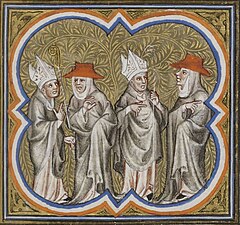
Back Westerse Skisma Afrikaans Abendländisches Schisma ALS Gran Cisma d'Occident AN الانشقاق الغربي Arabic الانشقاق الغربى ARZ Cisma d'Occidente AST Вялікі заходні раскол Byelorussian Папска схизма Bulgarian পশ্চিমী ক্যাথলিক গির্জার বিভেদ Bengali/Bangla Zapadni raskol BS
You can help expand this article with text translated from the corresponding article in French. (December 2018) Click [show] for important translation instructions.
|
| Part of the crisis of the late Middle Ages | |
 A 14th-century miniature symbolizing the schism | |
| Date | 1378–1417 |
|---|---|
| Location | Europe |
| Type | Christian Schism |
| Cause |
|
| Motive | International rivalries in Catholic Europe |
| Outcome | Reunification of Catholic Church in 1415–1429 |
The Western Schism, also known as the Papal Schism, the Great Occidental Schism, or the Schism of 1378 (Latin: Magnum schisma occidentale, Ecclesiae occidentalis schisma), was a split within the Catholic Church lasting from 1378 to 1417 in which bishops residing in Rome and Avignon both claimed to be the true pope, and were joined by a third line of Pisan claimants in 1409. The schism was driven by personalities and political allegiances, with the Avignon Papacy being closely associated with the French monarchy.
The papacy had resided in Avignon since 1309, but Pope Gregory XI returned to Rome in 1377. The Catholic Church split in 1378 after Gregory XI's death and Urban VI's election. A group of French cardinals declared his election invalid and elected Clement VII as pope. After several attempts at reconciliation, the Council of Pisa (1409) declared that both rivals were illegitimate and elected a third purported pope. The schism was finally resolved when the Pisan claimant Antipope John XXIII called the Council of Constance (1414–1418). The Council arranged the renunciation of both Roman pope Gregory XII and Pisan antipope John XXIII. The Avignon antipope Benedict XIII was excommunicated, while Pope Martin V was elected and reigned from Rome.
The affair is sometimes referred to as the Great Schism, although this term is usually used for the East–West Schism of 1054 between the churches remaining in communion with the See of Rome and the Orthodox Catholic Church.
© MMXXIII Rich X Search. We shall prevail. All rights reserved. Rich X Search